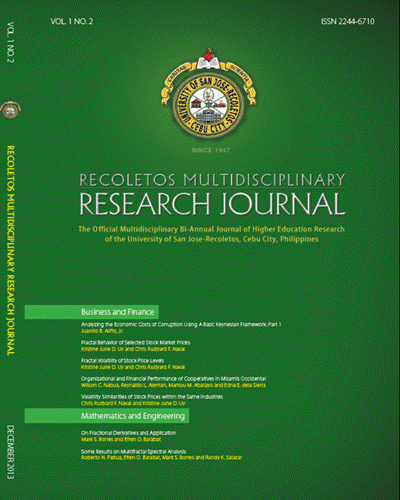Ubiquity of Fractals in Gerontology
DOI:
https://doi.org/10.32871/rmrj1301.02.19Keywords:
fractals, gerontology, older adults, older population, life expectancy, living arrangementAbstract
This study compares the fractal dimensions of certain characteristics of the aging population which exhibited irregularity in patterns such as population distribution, life expectancy and living arrangements in developed and developing countries. Data were gathered from on-line data base of United Nations organization. Findings revealed that the fractal dimension of living arrangement is 1.11 which is greater than that of life expectancy at 1.07. Fractal dimension of older population is 1.07, while the fractal dimension of living arrangement is 1.04. It is concluded that demographic distributions
in older adults are better predicted at a higher fractal dimension. It is concluded further that living arrangement and older population can reduce variability of distribution in life expectancy and living arrangement respectively.
References
Gesano, G. and Strozza, S. (2011). Foreign migrations and population aging in Italy. Genus Journal of Population Sciences. Retrieved fromhttp://scistat.cilea.it/index.php/genus/article/view/420 on October 17, 2013.
N.A. 2013. Facts about Germany. http://www.tatsachenueber-
deutschland.de/en/
Forex Fraternity Academy. 2012. The Characteristics of a
Fractals. Accessed at: http://forexfraternity.com/chapter-5-fractal-geometry/fractal-geometry/thecharacteristics-of-fractals
Iacovou, Maria. February 2000. The living arrangements of Elderly Europeans. Institute for Social and Economic Research.
IRIN Humanitarian News and Analysis, 2007. UN Office. www.irinnews.org
Kyodo. 2013. Japan Times News. http://www.japantimes.co.jp/news/2013/05/17/national/japan-still-topsin-life-expectancy/#.Ul9942JBN4w
Palloni, Alberto; Pinto-Aguirre & Martha Pelaez. 2002. Demographic and health conditions of ageing in Latin America and the Caribbean. International Journal of Epidemiology. Volume 4, Issue no. 4. Retrieved from http://ije.oxfordjournals.org/content/31/4/762.full
Palloni, Alberto. 2000. Living arrangements of older persons. Rajeshwar, D., Shambunath Singh, Pankaj Mala and Meena Dhyani. 2008. Needs Assessment Study among Urban Elderly: A Rapid Assessment. Help Age India Programs Department.
United Nations Department of Economic and Social Affairs/ Population Division. 2013. Living Arrangements of Older Persons around the World. Accessed at: http://www.un.org/esa/population/publications/
livingarrangement/report.htm.2010.World Population Aging.
Velkoff, Victoria. Living Arrangements and Well-being of the Older Population: Future Research Directions. United States Buraue of the Census. www. un.org
World Health Organization.2013. Global Health Observatory Data Repository. Life Expectancy by Country. 2013. Accessed at: http://apps.who.int/gho/data/node.main.688?lang=en
Downloads
Published
How to Cite
Issue
Section
License
Copyright of the Journal belongs to the University of San Jose-Recoletos


